3D printing is an additive-producing process that uses thin layers of filament (plastic) to make a physical item from a three-dimensional model. A digital record makes the model which ultimately moves to the printer. The 3D printer makes thin layers, one on top of another, until a 3D-printed object is shaped. This form of printing also allows the creation of models of more perplexing shapes with less material than traditional manufacturing procedures.
History of 3D Printing
Research shows that 3D printing was first introduced during the ’70s. It was only after 1980 that early additive manufacturing hardware and materials were created. Hideo Kodama, a Japanese inventor, started a patent for this technology but, unfortunately, never marketed it. During the ’90s 3D printing started to stand out from technologies around the world. These years also saw the creation of completely practical human organs for transplants in young patients using 3D printed techniques covered with particles and cells from their bodies. It was a significant success for the clinical business.
Despite these advancements, 3D printing had limited functional creations until the 2000s, while additive manufacturing acquired fame. Additive manufacturing is the most common way of adding materials together to deliver an item. The method of additive manufacturing is in stark contrast to the idea of subtractive producing.
Subtractive manufacturing is the method involved with eliminating material via cutting out a surface to make an item. This process also delivers a lot of material waste. In such a manner, the term 3D printing still refers more to advancements that use polymer materials, and additive manufacturing refers more to metalworking. But by the early 2010s, the details of these two cycles were used in famous language across the market, media, organizations, and makers.
Around 2008 the main self-replicating 3D printer model was made. That implies a 3D printer had the option to reproduce itself by printing its parts and components. This empowered clients to create more printers for other people. Studies show that later the same year, an individual effectively walked with a 3D-printed prosthetic leg completely imprinted in one piece.
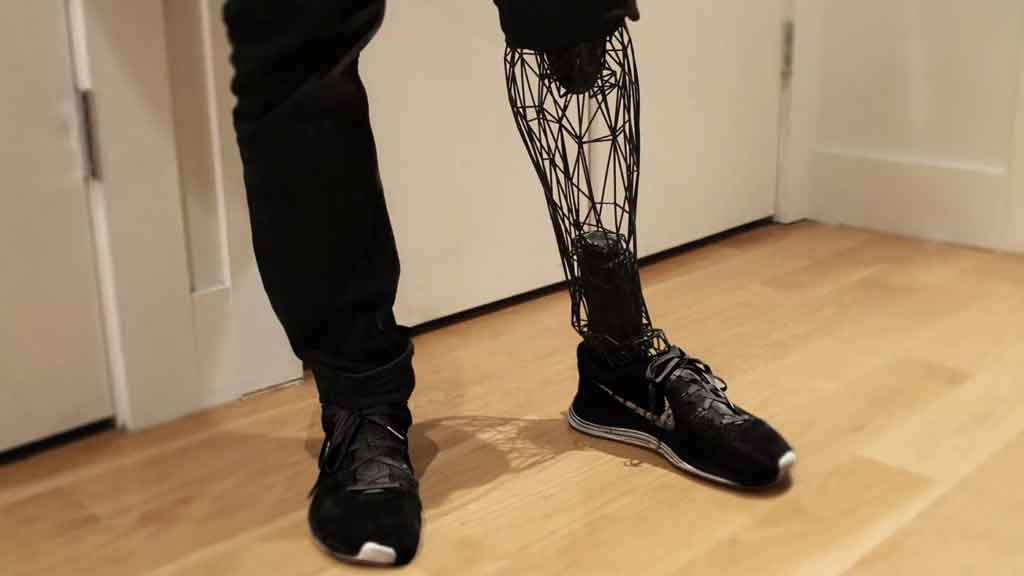
Then, at that point, in 2010 the additive processes matured, and 3D printing work started to make objects layer by layer. In 2012, with the addition of plastic and other different materials for 3D printing, a few creators started to feel that 3D printing could be significant for a developing world.
During the next years, more applications for 3D printing have arisen, including the world’s first aircraft. Manufacturers using 3D printers agree that this technique is quicker and less expensive contrasted with traditional strategies and is great for individuals who need fast prototyping (RP). Terms, for example, work area producing, quick assembling, and fast prototyping have since become synonymous with 3D printing.
The market offers a wide assortment of 3D printers. Complex machines are costly, but there are also more reasonable models available with great printing and features. 3D printing also offers easy-to-use desktop printers, which are progressively popular among schools and engineers.
How Does a 3D Printer Work?
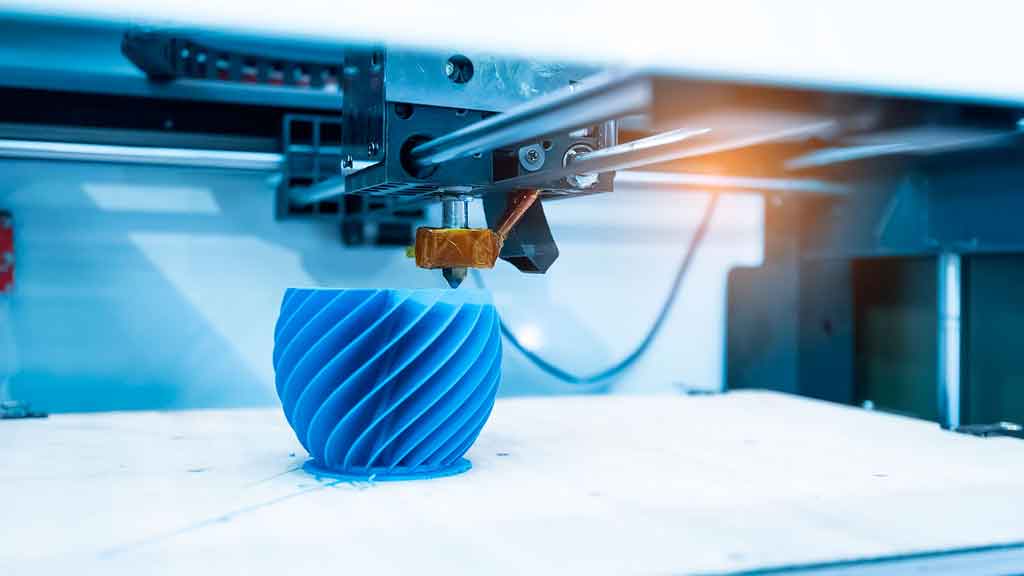
3D printing has reformed how we make products and items. It has opened up more opportunities in assembling, medication, art, and numerous different fields. But how can it work? In this section, we will explore the overall process involved with 3D printing, from modeling to printing.
3D Modeling
The starting phase in 3D printing is making a computerized model of the item you need to print. This should be possible by using 3D modeling software which allows you to make a virtual portrayal of your plan. There are various 3D modeling software choices available, going from free, open-source projects to professional-grade programming used by engineers and planners.
Whenever you have made your 3D model, you will need to export it in a format that can be perused by the 3D printer. The most widely recognized document design for 3D printing is STL (Standard Tessellation Language), which is a straightforward configuration that describes the surface geometry of the item.
Rendering
The next step is rendering, which includes setting up the 3D model for printing. This incorporates slicing the model into thin layers, creating support designs to hold the item set up during printing, and setting the printing boundaries like layer level and printing speed.
This step is mostly done using special software called a slicer, which takes the 3D model and converts it into a bunch of directions that the printer can comprehend. The slicer software allows you to change the settings to improve the printing system for your specific object and printer.
Printing
At last, now is the right time to print your object. The 3D printer works by storing layer upon layer of material, developing the object from the base up. The material used can vary depending on the printer, but a few normal materials incorporate plastic, metal, and even food.
The printer adheres to the instructions produced by the slicer software, moving the print head this way and forth to store the material in the right areas. As each layer is completed, the printer moves up to start the next layer, until the entire object is complete.
Finally, 3D printing is a complex cycle that includes a few stages, from modeling to printing. By understanding these means, you can easily appreciate the innovation behind this exciting and innovative field.
Different 3D Printing Processes and Working
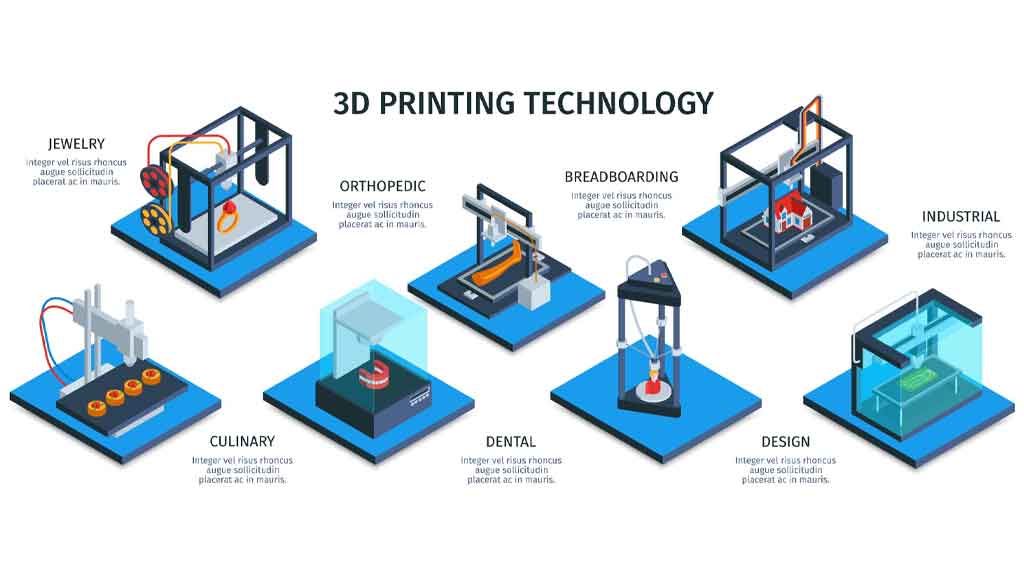
The term 3D printing technically refers to the advancement of any object starting from the earliest stage. This offset of additive manufacturing makes use of various processes to assist with achieving this work. No matter what the process used, the idea behind the making of items using 3D printing innovation continues as before; beginning from the development of a 3D model using CAD (computer-aided design) software to the setting up of the machine. However, the real process used to make the physical object differs.
There are four different kinds of 3D printing processes that you are probably going to review, these are as follows:
- Stereolithography (SLA)
- Selective Laser Sintering (SLS)
- Fused Deposition Modeling (FDM)
- Multi-Jet Modeling (MJM)
- Stereolithography (SLA)
The 3D printing process called stereolithography is generally viewed as the pioneer of any remaining 3D printing processes. Charles W. Body, the founder behind 3D frameworks, presented and patented this process in 1988. This process makes use of fluid photopolymer resin that is restored by a UV laser. The laser cements that resin layer by layer to make the entire item.
How it Functions
An SLA 3D printer gets going with an excess of liquid plastic. A portion of this plastic is cured (or solidified) to shape a 3D item.
There are four basic parts to an SLA printer:
• A printer filled with plastic
• A perforated platform
• A UV laser
• A PC that controls both the laser and the platform
In any case, a thin layer of plastic (placed between 0.05-0.15mm) is uncovered over the stage. The laser ‘draws’ the example of the item over the stage as depicted in the design documents. When the laser contacts the material, it hardens. This process is repeated until the entire object has been developed.
Objects that are created using SLA are generally smooth, while the nature of the item is dependent on the SLA machine.
- Selective Laser Sintering (SLS)
SLS is one of the most commonly used 3D printing technologies. During the SLS printing process, little particles of ceramic, glass, or plastic are fused by a powerful laser. The intensity from the laser fuses these particles to form 3D objects.
Carl Deckard, an undergrad understudy at the University of Texas, alongside his Teacher, Joe Beaman, created and patented this cycle during the 1980s.
How it Functions
Like any remaining 3D printing processes, the most common way of making an item with an SLS machine starts with designing a 3D model using computer-aided design software. These records are then converted into STL design, which is recognizable by 3D printers.
SLS uses powder materials, normally plastics like nylon, to print the 3D items. The laser is constrained by a PC which instructs it to print the fitting item by tracing a cross-part of the item onto the raw material (powder).
The heat from the laser is equivalent to, or slightly below, the edge of boiling over the particles. When the initial layer of the item is formed, the platform of the 3D printer drops by something like 0.1mm to uncover another layer of the powder. Layer by layer, the object is made, and it must be allowed to cool before being taken out from the printer.
- Fused Deposition Modeling (FDM)
The Fused Deposition Modeling printing process is an additive manufacturing innovation that is used for the reasons for modeling, prototyping, and creation applications. This technique also works by making an object layer by layer. However, there are a few distinctions in how the materials are used by this innovation.
How it Functions
3D printers that use the FDM innovation develop an item layer by layer; they heat a thermoplastic material to a semi-liquid state. Two materials are used by FDM to finish the printing, a modeling material and a support material. The previous comprises the result, while the latter acts as scaffolding.
The raw materials are provided from the printer’s bays and the printer head is intended to move based on X and Y organizes, controlled by the PC. It just moves vertically (Z-pivot) when a layer has been completed.
The benefits presented by FDM make it reasonable for use in workplaces, as it is a perfect and easy-to-use method.
- Multi-Jet Modeling (MJM)
The rule of working with a 3D printer using multi-jet modeling is unmistakably like that of an inkjet printer. This process is some of the time also referred to as thermojet. It is a kind of fast prototyping process that can make wax-like plastic models.
How it Functions
MJM printers have a head that has many linear nozzles that spray a colored glue-like substance onto a layer of resin powder. The way that this innovation doesn’t have similar kind of limitations as SLA, delivering detailed objects with thicknesses as fine as 16 microns may be capable. However, they aren’t as tough as those made using SLA.
Using this strategy, the printer can make a wax-like 3D item layer by layer.
Best 3D Printers for Beginners in 2023
Creality Ender-3 V2 Neo
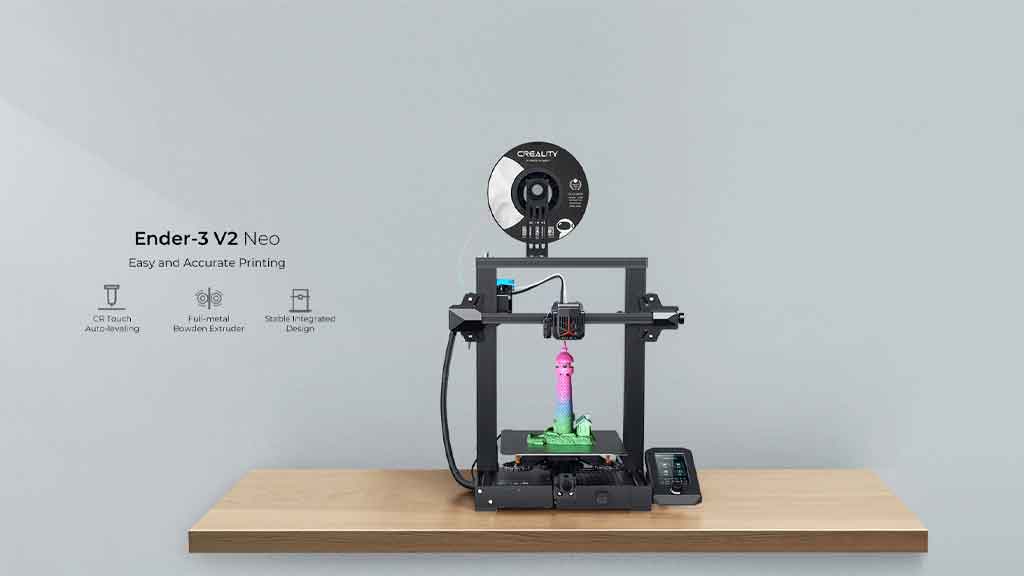
Key Features
• Materials upheld: PLA, ABS, PETG,
• Print volume (HWD): 8.7 x 8.7 x 9.8 inches
• Connectivity: Micro USB, TransFlash memory card
• Dimensions (HWD): 17.2 x 16.7 x 18.6 inches
• Weight: 21.60 lbs.
Pros
• Modest
• Its redesign improves the overall of it
• Quicker than predecessor
Cons
• The Learning curve can be steep for some
The new cycle of this Creality 3D printer incorporates a few great upgrades to a generally solid-performing 3D printer. Its CR-Contact feature, for example, gathers the bed deviation information by contacting different focuses in the bed and making up for them appropriately, allowing for hassle-free bed leveling. It presently accompanies a full-metal Bowden extruder, which the organization expresses makes for smooth feeding through the system.
Creality has also overhauled the UI: Its new 4.3-inch UI is simpler to read. It also has another form plate: The PC spring steel magnetic build plate has great adhesion to the model, and it empowers speedy removal of the print with only a slight curve of the stage.
With prints comparing 8.7 x 8.7 x 9.8 inches, this model can easily produce the absolute most famous 3D-printed objects like fidget toys, new parts, and gaming miniatures.
Original Prusa i3 MK3S+
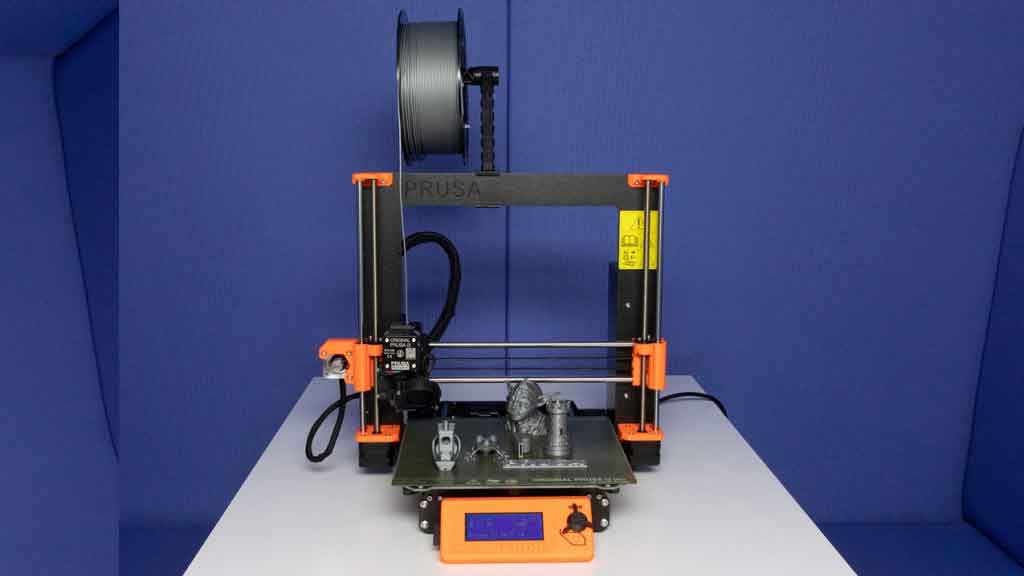
Key Features
• Materials upheld: PLA, ABS, PETG, ASA,
• Print volume (HWD): 9.8 x 8.3 x 8.3 inches
• Connectivity: USB, SD Card
• Dimensions (HWD): 19.6 x 21.6 x 15.7 inches
• Weight: 15.4 lbs.
Pros
• Produces brilliant quality prints
• Very versatile
• Simple to Use
• Solid
Cons
• A bit expensive
This well-built Prusa 3D printer is for pretty much any client, from those simply getting everything rolling to those who’ve been 3D printing for quite a long time. That is because the i3 MK3S+ conveys excellent results for typical home clients, a large number of times. But it’s not simply reliable. It also creates brilliant quality prints with loads of detail, which is partly because of the 3D printer’s exceptionally strong form quality, which guarantees those details will be delivered accurately. Likewise, the i3 MK3S+ has fewer errors during the printing system than different models in its group.
However, it’s anything but an ideal 3D printer. We had several minor objections with the i3 MK3S+: For example, it has a decent-sized 3.4-inch display, however, the display is monochrome and not a touchscreen. (Different models have color touchscreens.) You can connect effectively enough using an SD card to add your work to the machine. However, if you need to interface via Wi-Fi, you’ll require an accessory — a Raspberry Pi Zero W.
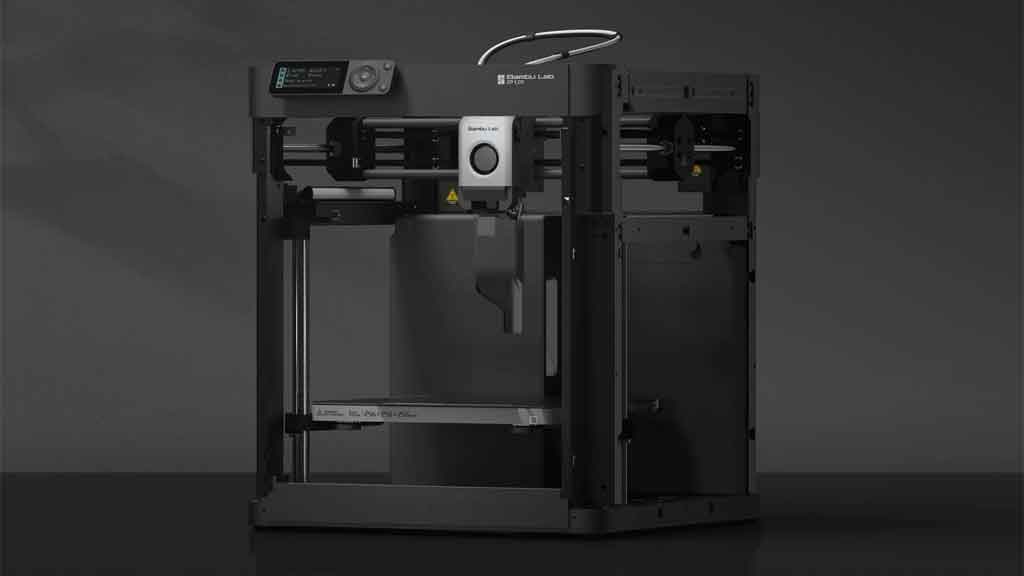
Key Features
• Materials upheld: PLA, ABS, PETG
• Print volume (HWD): 10 x 10 x 10 inches
• Network: Wi-Fi, Bluetooth, SD Card
• Dimensions (HWD): 15.2 x 15.3 x 18 inches
• Weight: 21.3 lbs.
Pros
• Extremely quick printing speed
• Amazing print quality
• Simple to set up
• Can print in various colors
Cons
• Expensive
• A bit noisy
While this printer is pricier than the other models on this list, it could save you significant time. It times in at somewhat more than multiple times the speed of various customer 3D printers. While most 3D printers produce PLA objects at a speed of 60mm/s (various materials will quicken or slow down the speed), the greatest speed of the Lab P1P’s tool head is 500 mm/s, as indicated by the maker. But what’s important to note is that even though this model has a lot quicker printing speed, the nature of the 3D printing isn’t impacted. Such a speed-up can be incredibly significant if you’re involving the Lab P1P for a small business. It’s also significant no matter how you use it since no one likes to waste time waiting around for 3D prints.
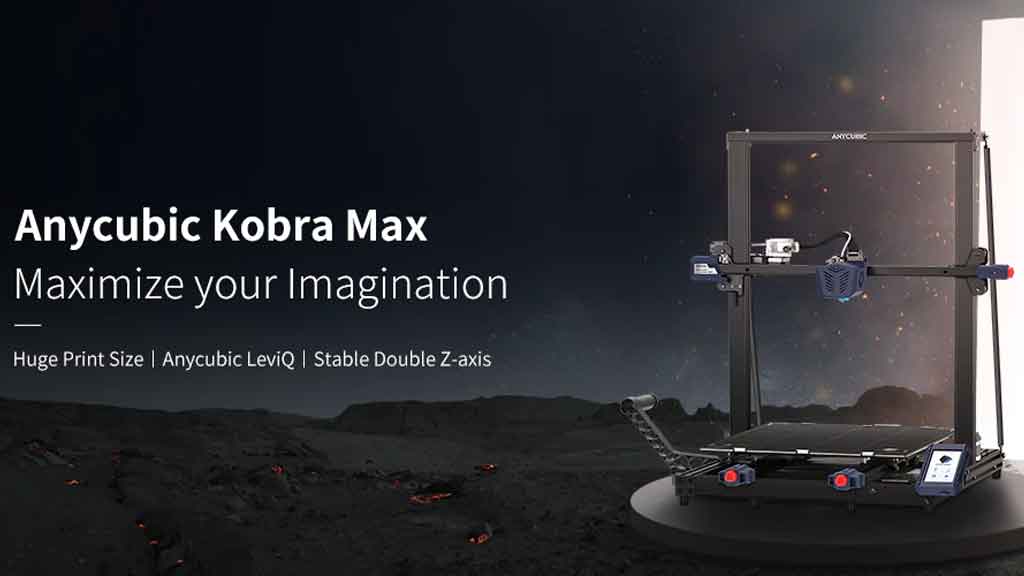
Key Features
• Materials supported: PLA, ABS, PETG, TPU
• Print volume (HWD): 17.7 x 15.7 x 15.7 inches
• Connectivity: MicroSD card
• Dimensions (HWD): 28.4 x 28.2 x 26.2 inches
• Weight: 43 lbs.
Pros
• Its huge size allows you to print scale projects
• Incorporates automated features, similar to its 25-point auto-leveling function
Cons
• Projects take more time to print
• The unit is huge and heavy
If you want to deliver projects that are to some degree bigger than your average-sized 3D printer can create, you’ll need to look at this Anycubic model. Its build volume is 17.7 x 15.7 x 15.7 in., which is fundamentally bigger than most models in its group. However, one of the disadvantages of the bigger space is that it takes more time to print your things. It also requires more work to calibrate the bigger printing field and bigger prints require more filament.
The 3D printer also comes packed with other valuable features: it has a self-developed Anycubic LeviQ leveling function, which uses the printer’s 25-point smart and exact adjustment system to compensate for the warmed bed unevenness automatically. That implies, as per the organization, leveling and printing can be finished with only the press of a button.
Monoprice MP Cadet
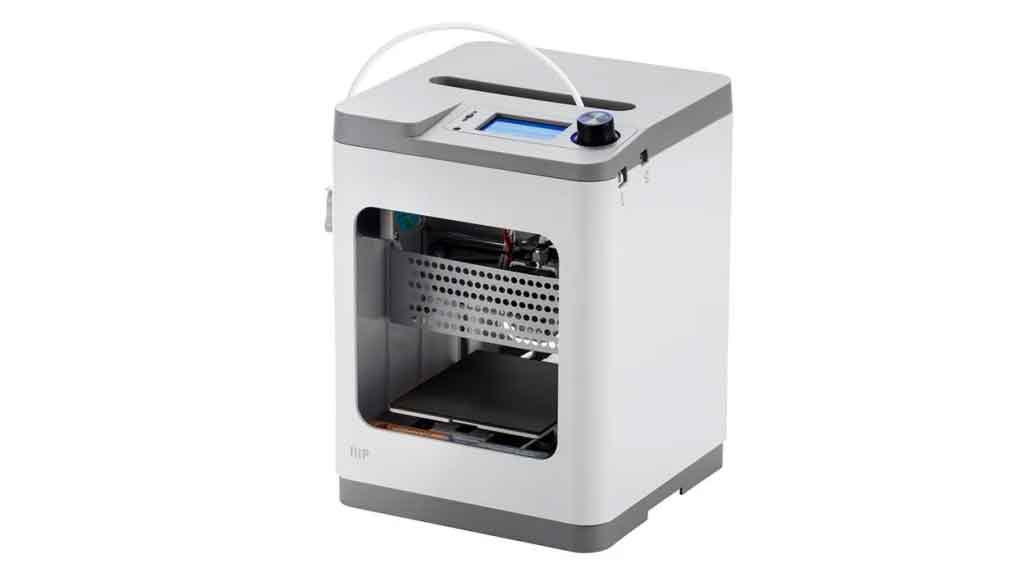
Key Features
• Materials upheld: PLA, PLA Ace
• Print volume (HWD): 3.9 x 4.1 x 3.9 inches
• Connectivity: USB, Wi-Fi, microSD card
• Dimensions: 8.3 x 8.3 x 11.4 inches
• Weight: 6.6 lbs.
Pros
• Little, compact, and lightweight
• Fast set-up time
• Accompanies auto-leveling feature
Cons
• Little print volume
• Not as versatile as different models
Although there are a lot of 3D models that you pay a lot of cash for, there is also a good choice of 3D printers that are inexpensive, similar to this model from Monoprice, which makes it a great model for beginners and students. If you simply have any desire to begin printing without diving into the interaction, this is a quick, simple choice.
Despite its small size, however, it’s a solid performer: It can print moderately rapidly. It’s also viable with Ultimaker Cura, an open-source slicing application for 3D printers, as well as wiibuilder software. In particular, this printer conveys good quality prints reliably. However, it’s not generally as flexible as some other, more feature-packed entry-level 3D printers.
With that low cost, expect a few drawbacks. The essential limit here is the print size, which tops out at around four inches on every axis.
Key Steps to Set Up a 3D Printer
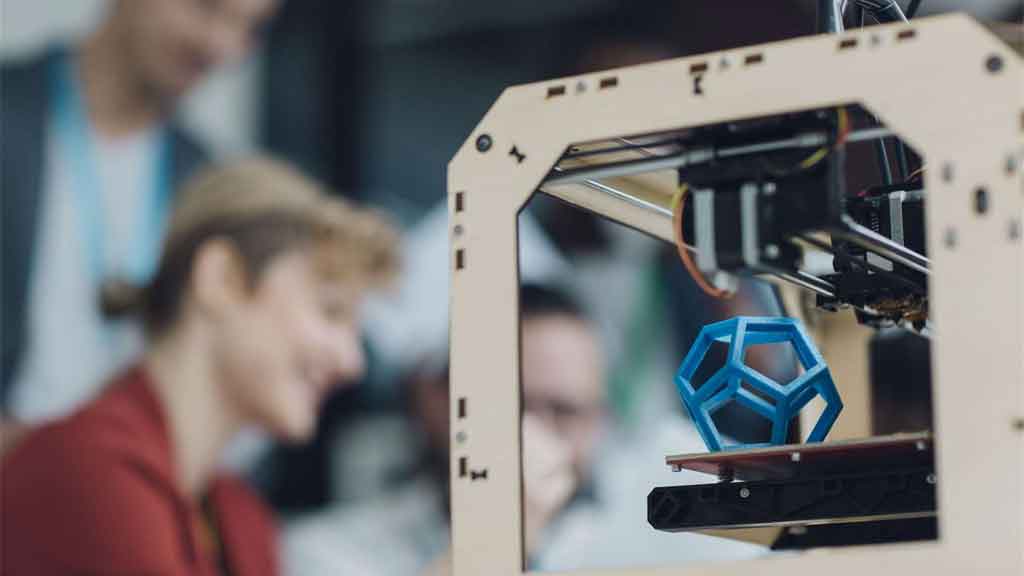
1. Make a Computer-Aided Design (CAD Design) record
The first step to making a 3D printed object is making a virtual design with PC software or a 3D scanner. On this, the specific dimensions of the item to assemble are simulated to perceive how this will look like while completing the 3D printing. While designing a 3D item using computer-aided design, fewer errors might result while printing, and luckily, these can be corrected before the process. There is also one more approach to making an item physically, such as sculpting where a 3D scanner is expected to gather the information, shape, and presence of the desired object.
2. Convert the CAD file
When the design is being made, the next thing is to convert the document into an organization that can be read by the 3D printer. One of the most common records used is STL (standard tessellation language). STL records may once in a while make a bigger document due to the quantity of surfaces. There is also one more choice of a file format used named AMF, Additive Manufacturing File format that stores data all the more conveniently.
3. Control the STL record
When the STL record is made, and ready to be sent to the 3D printer, the direction and size for the item to be printed should be set. STL records also allow us to fix any irregularities in the original.
4. Set up the 3D printer
Once the digital file is fit to be printed, all materials should be prepared to begin the printing system. When the STL record is prepared, then, at that point, it should be processed by slicing software that guides in the 3D printing process by changing the object into layers and giving the instructions that later will be gotten by the 3D printer.
5. Build the object
When every one of the mentioned parameters is prepared, the printing system can start. A few printers might take some time to make the final product as this really relies on how complex is the item to print. Numerous printers have very good quality capacities and print quickly. At the point when the process starts, the layers start to build the item with an incomparable resolution using a special measure of micrometers. For example, the thickness of a typical layer is around 100 micrometers.
6. Process the last piece
When the item is prepared, this should be handled very cautiously. For example, putting gloves to deal with the printed thing is recommendable at last dismiss any residual powder to tidy up the piece. One of the upsides of 3D printing is that a piece can be made within hours, contrasted with traditional cycles of manufacturing, this is very helpful and shows quicker results.
3D Printing Materials
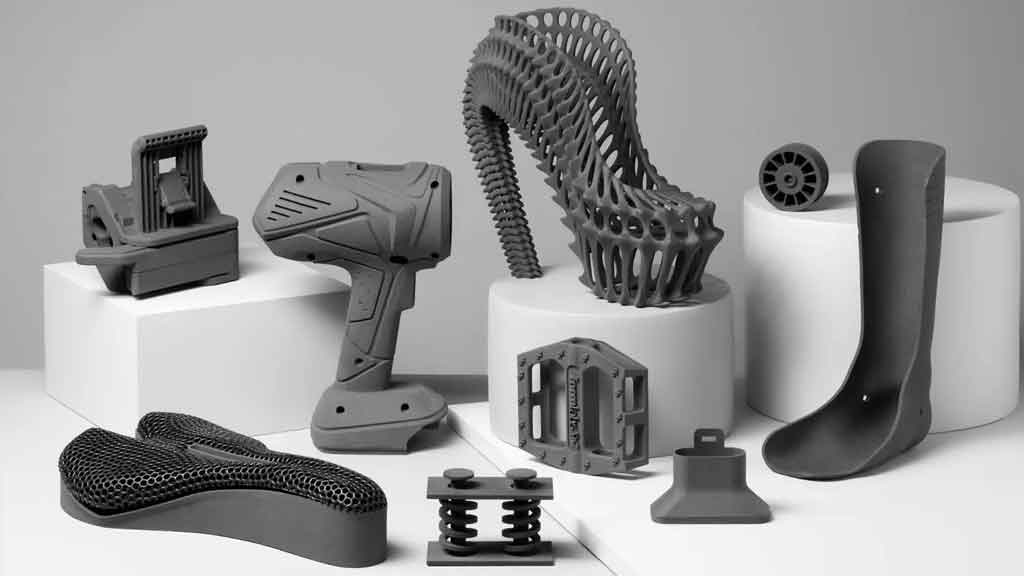
The materials available for 3D printing have made considerable progress since the beginning of the technology. There is presently a wide range of material kinds that are provided in various states (powder, filament, pellets, granules, resin and so on).
Specific materials are now commonly created for specific stages performing dedicated applications (a model would be the dental area) with material properties that more precisely suit the application.
Nonetheless, there are currently an excessive number of proprietary materials from a wide range of 3D printer sellers to cover them generally here. All things being equal, this section will check out the popular kinds of material in a more generic manner. And also, several materials that stand out.
Plastics
Nylon, or Polyamide, is commonly used in powder form with the sintering system or in filament structure with the FDM cycle. It is a flexible, strong and tough plastic material that has proved reliable for 3D printing. It is normally white but it tends to be shaded — pre- or post-printing. This material can also be joined (in powder design) with powdered aluminum to create one more typical 3D printing material for sintering — Alumide.
ABS is one most common plastics used for 3D printing and is generally involved on the entry-level FDM 3D printers in filament structure. It is an especially impressive plastic and arrives in many colors. ABS can be purchased in filament structure from various non-proprietary sources, which is another justification for why it is so well known.
PLA is a bio-degradable plastic material that has built up some momentum with 3D printing for this very reason. It tends to be used in resin design for DLP/SL processes as well as in filament structure for the FDM cycle. It is presented in different colors, including transparent, which has been demonstrated to be a helpful choice for different applications of 3D printing. However, it isn’t as tough or as adaptable as ABS.
Metals
A developing number of metals and metal composites are used for industrial-grade 3D printing. Two of the most widely recognized are aluminum and cobalt subordinates.
One of the strongest and most regularly involved metals for 3D printing is Treated Steel in powder structure for the sintering/softening/EBM processes. It is normally silver but can be plated with different materials to give a gold or bronze impact.
Over the recent few years, Gold and Silver have been added to the range of metal materials that can be 3D printed directly, with clear applications across the jewelry area. These are both very impressive materials and are handled in powder structure.
Titanium is one of the strongest conceivable metal materials and has been used for 3D printing industrial applications for quite a while. Provided in powder structure, it can be used for the sintering/softening/EBM processes.
Ceramics
Ceramics are a moderately new group of materials that can be used for 3D printing with different degrees of progress. The specific thing to note with these materials is that post-printing, the ceramic parts need to go through similar cycles as any ceramic part made using conventional techniques for creation — to be specific firming and glazing.
Paper
Standard A4 copier paper is a 3D printing material used by the exclusive SDL process provided by Mcor Innovations. The organization works on a notably unique plan of action for other 3D printing vendors, by which the capital expense for the machine is in the mid-range, but the emphasis is a lot on an effectively possible, cost-effective material supply, that can be purchased locally. 3D printed models made with paper are protected, harmless to the ecosystem, effectively recyclable and require no post-handling.
Biomaterials
There is a large amount of research being directed into the capability of 3D printing biomaterials for a large group of medical (and other) applications. Living tissue is being examined at various leading institutions with the end goal of creating applications that incorporate printing human organs for transplant, as well as outside tissues for substitution of body parts. Other research in this space is focused on creating foodstuffs — meat being a great representation.
Food
Experiments with extruders for 3D printing food substances have expanded emphatically over the last few years. Chocolate is the most well-known (and desirable). Some printers work with sugar and a few investigations with pasta and meat. Planning and research are being attempted to use 3D printing innovation to deliver finely balanced whole meals.
Applications of 3D Printing
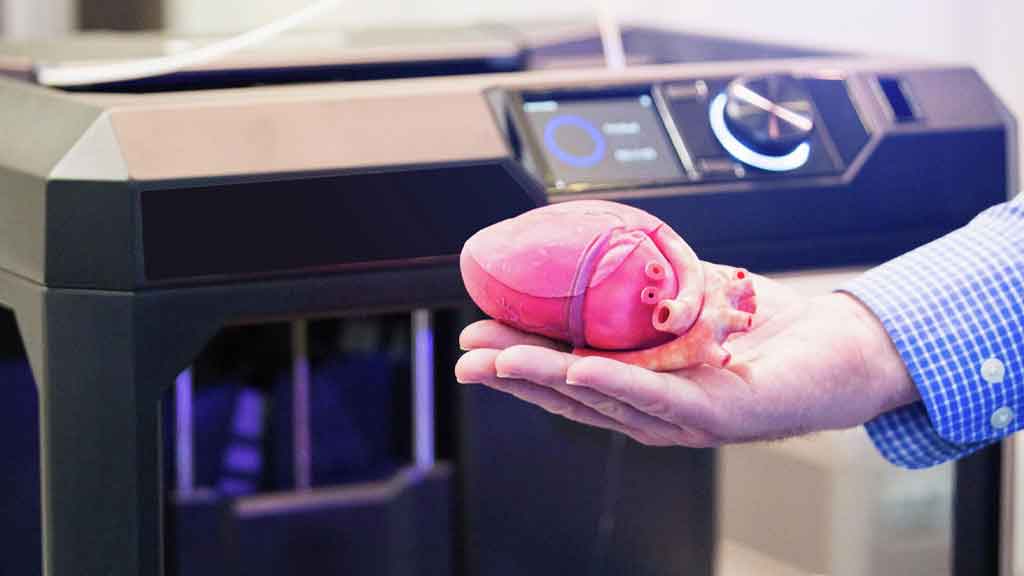
3D printing, otherwise called additive manufacturing, has many applications across different businesses because of its flexibility and capacity to make complex shapes and redid parts. Here are a few notable applications of 3D printing:
1. Prototyping and Fast Prototyping: 3D printing is generally used in item advancement to make prototypes quickly and cost-effectively. It allows architects to test and refine their ideas before putting resources into traditional manufacturing processes.
2. Customized Medical Implants: 3D printing is changing the medical care industry by empowering the development of custom implants, prosthetics, and orthodontic devices tailored to individual patients’ requirements.
3. Dental Applications: Dentists use 3D printing to make dental models, crowns, bridges, and aligners. It further develops accuracy and reduces creation time compared with traditional techniques.
4. Aerospace: Aerospace organizations use 3D printing to fabricate lightweight and complex parts, lessening weight and expanding fuel efficiency in airplanes and spacecraft.
5. Automotive: Vehicle makers use 3D printing for prototyping, tooling, and even producing specific vehicle parts, like inside parts and customized accessories.
6. Architecture: Architects use 3D printing to make itemized scale models of buildings and designs, assisting clients in visualizing the last plan.
7. Fashion and Jewelry: 3D printing allows planners to make mind-boggling and interesting jewelry pieces and design accessories that would be trying to create through traditional strategies.
8. Art and Model: Artists and sculptors use 3D printing to rejuvenate their innovative ideas, creating intricate and complex artworks.
9. Consumer Goods: Customization is a developing pattern, and 3D printing empowers the production of customized purchaser items, for example, cell phone cases, figurines, and home decor.
10. Education: 3D printing is a significant device in schooling, assisting students in understanding complex ideas in science, engineering, and design by allowing them to make physical models.
11. Food: A few organizations are exploring 3D printing for food creation, making complex and visually appealing dishes or customizing food for dietary limitations.
12. Construction: Huge-scope 3D printers can make building parts, like walls and structural elements, possibly reforming the construction business by reducing expenses and construction times.
13. Defence: The military uses 3D printing for delivering spare parts on demand and making particular gear and instruments.
14. Electronics: 3D printing is used to make custom fenced-in areas and housings for electronic devices and prototypes for new devices.
15. Drones and Robotics: 3D printing considers the fast prototyping and customization of drone parts and robotic parts, empowering development in these fields.
Common 3D Printing Challenges Beginner’s Face
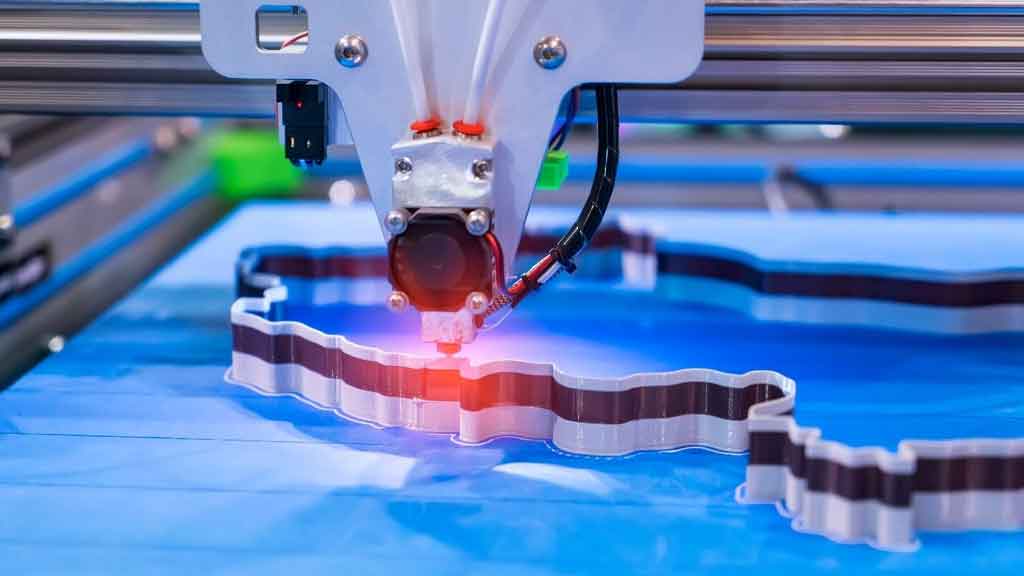
Beginners in 3D printing frequently face some challenges as they begin to explore this innovation. Here are a few common challenges and difficulties they might experience:
1. Learning Curve: 3D printing includes a fair measure of technical information. Beginners should find out about various 3D printing technologies, software, hardware, and materials, which can overwhelm them.
2. Choosing the Right Printer: Choosing the right 3D printer can challenge. Beginners need to consider factors like financial plan, expected use, build volume, and the sort of materials they plan to use.
3. Calibration and Setup: Properly calibrating the 3D printer is important for achieving precise prints. Beginners might battle with leveling the print bed, adjusting the nozzle level, and guaranteeing that the printer’s parts are accurately gathered.
4. Design and Modeling: Making or finding 3D models for printing can be challenging, particularly for people who are curious about 3D design software. Figuring out how to use design tools like Tinkercad or further developed programs like Blender or Fusion 360 can take time.
5. File Format Compatibility: Ensuring that 3D models are in the right file format and are viable with the chosen slicing software and 3D printer can be confusing for beginners.
6. Slicing Software: Slicing software is used to change 3D models into instructions for the printer. Beginners might find it hard to comprehend how to arrange slicing settings for their particular printer and materials.
7. Material Selection: Various materials have special properties and printing requirements. Beginners could battle to pick the right material for their work and learn how to accurately deal with it.
8. Printing Failures: It’s normal for beginners to encounter print failure due to issues like misaligned layers, twisting, grip issues, or extruder clogs. Troubleshooting and understanding the main causes of these issues can be frustrating.
9. Post-Processing: After printing, parts might require post-handling, for example, sanding, painting, or collecting. Beginners might come up short on abilities or tools required for these tasks.
10. Safety Concerns: Beginners should know about safety precautions, particularly while managing heated build plates, hot extruders, and potentially harmful vapor from specific materials.
11. Time and Patience: 3D printing can be time-consuming, particularly for bigger or complex prints. Beginners might have to practice patience and understand that the process can require hours or even days.
12. Maintenance: Normal maintenance of the 3D printer is fundamental for keeping it in great working condition. Beginners should be ready to learn how to clean, lubricate, and troubleshoot their printer.
13. Cost Management: While 3D printing can be cost-effective for activities, beginners may not at first expect costs related to printer maintenance, materials, and updates.
14. Copyright and Licensing: Understanding copyright and licensing issues connected with 3D models particularly if sharing or selling prints is essential to avoid legal issues.
Advantages of 3D Printing Over Traditional Manufacturing
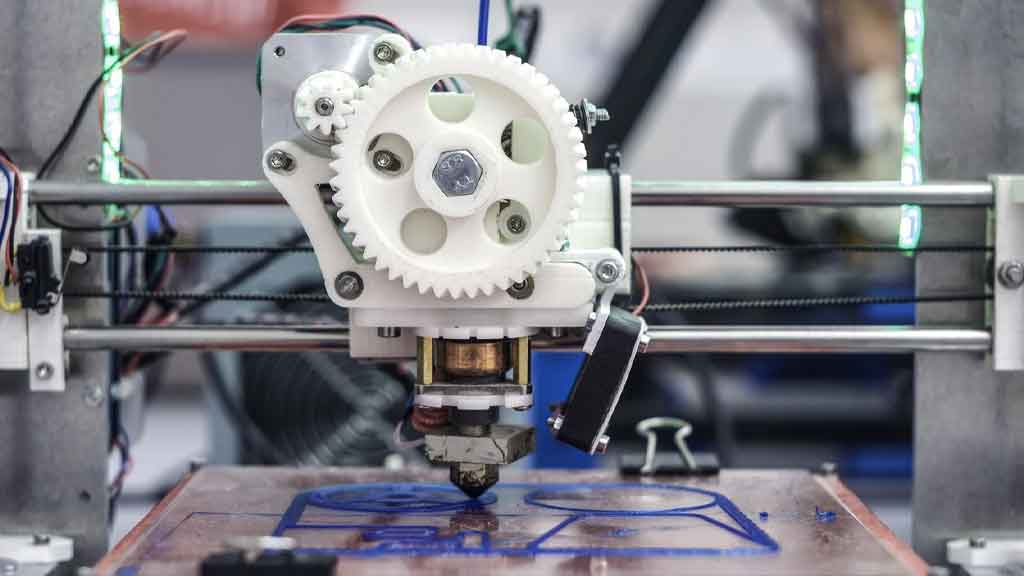
3D printing, otherwise called additive manufacturing, is a process of making a three dimensional object from a computerized model. It works by developing the object layer by layer, using different materials like plastic, metal, and ceramic.
3D printing offers various advantages over traditional manufacturing processes, including:
• Design freedom: 3D printing allows for the production of items with complex geometries that would be troublesome or difficult to create using traditional techniques.
• Fast prototyping: 3D printing can be used to rapidly create models of new items, which can assist with accelerating the design and development process.
• On-demand manufacturing: 3D printing can be used to create objects on request, which can decrease inventory expenses and lead times.
• Reduced waste: 3D printing uses simply the material needed to make the object, which can assist to reduce waste.
• Mass customization: 3D printing can be used to create customized items for individual clients.
• Sustainability: 3D printing can be used to deliver sustainable items, for example, those produced using recycled materials.
In addition to these general advantages, 3D printing also offers various specific advantages for various enterprises. For example, in the medical industry, 3D printing can be used to make custom prosthetics and implants, as well as to print human tissue and organs. In the aerospace industry, 3D printing can be used to deliver lightweight and complex parts for aircraft and spacecraft. Furthermore, in the consumer goods industry, 3D printing can be used to deliver altered items like jewelry, eyewear, and clothing.
In general, 3D printing is a flexible and strong innovation with a large number of potential advantages.
Wrapping Up
3D printing is a quickly developing innovation with the possibility to revolutionize numerous businesses. It offers various advantages over traditional manufacturing processes, including design freedom, fast prototyping, on-request production, decreased waste, mass customization, and maintainability.
3D printing is already being used in many applications, including medication, aviation, consumer products, and automotive. As the innovation proceeds to create and become more reasonable, it is likely to have an even greater impact on the world.
Overall, the conclusion of 3D printing is exceptionally encouraging. It is a versatile and strong innovation with the possibility to significantly affect numerous parts of our lives.
Frequently Asked Questions
1) What is the definition of 3D printing?
3D printing or additive manufacturing is the latest manufacturing process that work with the production of strong three-dimensional objects through a series of stages. 3D printers produce objects physically by social occasion inputs from three-dimensional digital models. They construct the object or model by saving material or filament layer by layer as per the digital 3D model. However, the printing system differs across 3D printing technologies.
2) How does 3D printing technology work?
A 3D printer builds the ideal item or thing by interpreting the computerized 3D model. The digital model ready by you should be sliced or prepared to give the 3D printer the expected data and instructions. The 3D printer will build the item genuinely by saving a single layer of material at a time according to the sliced 3D model. But you should recall that each type of 3D printer builds the item physically in a specific way.
3) What are the three important stages in 3D printing?
Additive manufacturing or 3D printing is a multistage cycle. An object or thing is 3D-printed in three significant stages – readiness/pre-processing, building, and getting done/post-handling. In the pre-processing stage, the digital file is ready and handled given which the 3D printer will print the thing. The 3D printer builds the object in the building stage by saving filament layer by layer as per the digital document. Finally, the 3D-printed thing is taken out from the support structure and cleaned or painted during the post-processing or completing stage.
4) Can I 3D print things of varying shapes?
You can use a 3D printer to deliver physical objects of differing shapes and sizes from digital 3D models. In any case, you can’t use a single 3D printer to create things of varying kinds and sizes. You should remember the build volume to pick and use the right 3D printer.
5) What should I consider before 3D printing a thing?
You can’t change over a three-dimensional digital record into a strong three-dimensional object without using the fitting 3D printing innovation and filament. That is the reason; you should focus on considering the right 3D printing innovation and filament by thinking about the item’s size, shape, goal, wall thickness, and resolution. Simultaneously, you also need to focus on the two pre-processing and post-handling exercises to ensure that the 3D-printed object meets predefined necessities.
6) How long does it require to 3D print an object?
Some 3D printing technologies are quicker than others. Subsequently, the printing time will shift as indicated by your choice of 3D printing innovation. Also, the size and state of the item will affect the 3D printing time directly. For example, you will require more opportunity to 3D print a bigger thing than a smaller thing.
7) What are generally used 3D printing advances?
You have the choice to look over an extensive variety of 3D printing technologies as indicated by the precise needs of the thing to be 3D-printed. Every 3D printing innovation shapes a strong three-dimensional object by depositing and restoring filament in a specific way. That is the reason; you should remember the differences between generally used 3D printing technologies like Fused Deposition Modeling (FDM), Stereolithography (SLA), Specific Laser Sintering (SLS), Digital Light Processing (DLP), and Selective Laser Melting (SLM).
8) Can I choose from a wide range of 3D printing materials?
While 3D printing an item, you have the choice to browse many materials or filaments. However, you should recall that 3D printing materials differ from one another in numerous perspectives, including physical and chemical properties. That is the reason; you should remember the nature, requirements, and use of the 3D-printed thing to pick the ideal filament for your 3D printing project.
9) Can I 3D print a thing without investing in a 3D printer?
You can avail of professional 3D printing services to change your thoughts into a three-dimensional thing without purchasing either a 3D printer or 3D printing filaments. Proficient 3D printing service providers make three-dimensional objects based on your advanced document joining the right 3D printer and filament. Thus, you could 3D print the ideal thing basically by sharing your plan with the 3D printing service provider as a digital record.
10) What are the common applications and use cases of 3D printing?
As of now, 3D printing advancements are being used by enterprises from different industries. Thus, the applications and use cases of 3D printing fluctuate across businesses. For example, medical companies use 3D printers to manufacture and test a variety of customized health devices and surgical instruments. Simultaneously, educational organizations influence 3D printing to work with STEM education. Also, enterprises from different sectors have been making new use instances of 3D printing technologies regularly.

